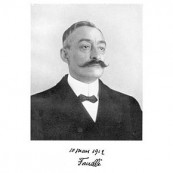传记
Ernest Fanelli (1860–1917) was a French composer of Italian descent who is best known for sparking a controversy about the origins of Impressionist music when his composition Tableaux Symphoniques was first performed in 1912. George Antheil asserted that Fanelli was "one of the greatest inventors and musical iconoclasts of all time",[1] but he remains an obscure figure.
Fanelli was born in Paris on 29 June 1860, his family having emigrated to France from Bologna. He studied music at the Paris Conservatoire for a few years from 1876, but was expelled because of his disputes with the teaching staff. The claim that he studied there with Charles-Valentin Alkan[2] is mistaken, as Alkan quit the Conservatoire in 1848, but he may have studied with Alkan's brother, Napoléon, who was the Conservatoire professor of solfège at the time. Fanelli worked as a timpanist before returning to musical studies under Léo Delibes. Again he failed to complete his studies, this time for lack of funds, and returned to work as a jobbing percussionist. He continued in self-taught studies of composition and began to create his own works.[1]
In 1912 Fanelli was seeking work as a musical copyist, and submitted a manuscript to Gabriel Pierné as an example of his neat handwriting. Pierné was intrigued by the music itself, which Fanelli told him was one of his own compositions, Tableaux Symphoniques, written nearly 30 years earlier. Pierné found evidence of radical musical innovations anticipating the recent work of Claude Debussy. He arranged for Thebes, the first part of the Tableaux, to be performed, creating a sensation in the musical press.[1] Pierné later performed several other works by Fanelli. Debussy himself reviewed the work, taking a sceptical view that Fanelli had "an acute sense of musical ornamentation" but that it "dragged [him] towards such an extreme need of minute description" that it made him "lose his sense of direction.".[1]
Fanelli was supported by Judith Gautier, the daughter of Théophile Gautier, whose novel The Romance of the Mummy had inspired the Tableaux Symphoniques. Gautier sponsored a private performance of the work and helped to fund him to produce transcriptions of his works.[3]
Fanelli himself was unable to capitalise on his new fame. He had given up composing in 1894, several years before he became well known, and could not or would not resume creative work. He continued to work as a performer to support his wife and children and died a few years later.







